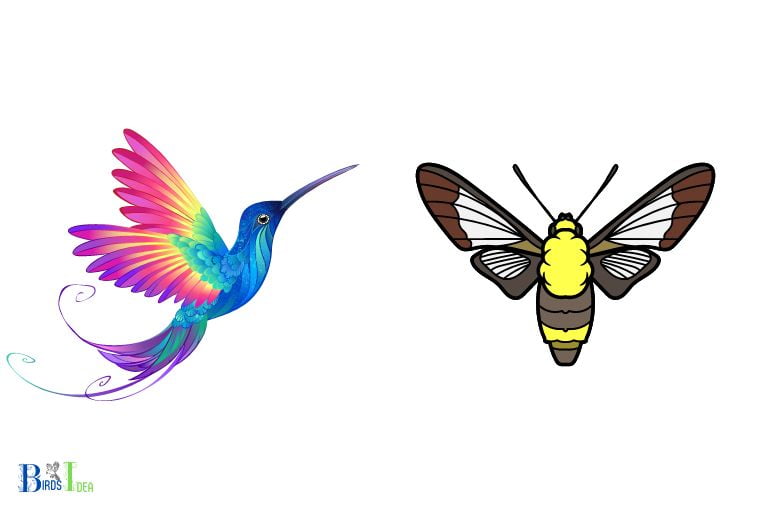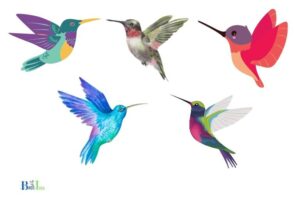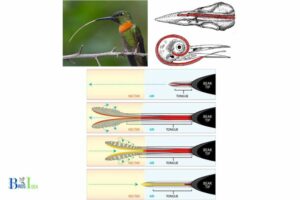Snowberry Clearwing Vs Hummingbird Clearwing: 9 Com!
Snowberry clearwing and Hummingbird clearwing are two different species of moth that are native to North America.
The Snowberry Clearwing (Hemaris diffinis) is a diurnal moth that is found in wooded areas of the eastern and western parts of the United States and Canada.
The Hummingbird Clearwing (Hemaris thysbe) is also a diurnal moth, but it is found in more temperate regions, and it is more common in northern parts of the United States.
The main differences between the two moths is size, coloration, and habitat preferences.
The Snowberry Clearwing is typically larger than the Hummingbird Clearwing, with a wingspan ranging from 1.5 to 2 inches long.
The wings of the Snowberry Clearwing are generally a pale orange or yellow color and they have bold black spots.
The Hummingbird Clearwing is typically smaller, with a wingspan of 1 to 1.5 inches, and its wings are brightly colored with red spots on a grayish or whitish background.
9 Comparisons of Snowberry Clearwing and Hummingbird Clearwing
| Comparison | Snowberry Clearwing | Hummingbird Clearwing |
| Species Name | Hemaris diffinis | Hemaris thysbe |
| Common Name | Bumblebee Moth | Hummingbird Moth |
| Size | Around 1.25 to 2 inches in wingspan | 1.5 to 2 inches in wingspan |
| Color | Body is olive to golden-olive in color with red bands | Body is olive green and burgundy with white bands |
| Habitat | Found across the United States, southern Canada, and Mexico | Found from Alaska to Oregon and across to Maine in the United States, and northern Canada |
| Diet | Larvae feed on honeysuckle and other plants; adults feed on nectar | Larvae feed on cherry trees and other plants; adults feed on nectar |
| Flight Pattern | Quick flight, often mistaken for a bumblebee | Quick and darting flight, often mistaken for a hummingbird |
| Active Time | Daytime | Daytime, but is especially active at dusk |
| Life Cycle | 2 generations per year in the south, 1 in the north | Usually 1 generation per year |
Key Takeaway

Four Facts About: Snowberry Clearwing and Hummingbird Clearwing
DID YOU KNOW
It is estimated that there are nearly 3,000 species of moths native to North America.
Comparing Snowberry Clearwing and Hummingbird Clearwing Moths
Snowberry Clearwing and Hummingbird Clearwing moths both belong to the Sphingidae family. These moths are found throughout North America and parts of Europe.

There are a few key differences between the two species:
- Geographic Range: Snowberry Clearwing moths are found in North America, while Hummingbird Clearwing moths are found throughout North America and parts of Europe.
- Size: Snowberry Clearwing moths are usually smaller than Hummingbird Clearwing moths.
- Wing Pattern: Hummingbird Clearwing moths have a distinctive black and white pattern on their wings, while Snowberry Clearwing moths have a more solid light brown color on their wings.
- Behavior: Hummingbird Clearwing moths are known to hover around flowers while Snowberry Clearwing moths remain stationary when feeding on the nectar of flowers.
Overall, Snowberry Clearwing and Hummingbird Clearwing moths are two species of moths that have a few key differences.
They are both found in different parts of the world, have different wing patterns and behaviors, and vary in size.
How Do The Two Moths Differ in Size?
The two moths, the gypsy moth and the luna moth, differ in size. The gypsy moth is slightly larger than the luna moth, typically reaching a wingspan of around 3 to 4 inches in comparison to the luna moth’s 2.5 to 3.8 inches.

Below are some differences in the sizes of the two moths:
- The adult gypsy moths have a wingspan of up to 4 inches, whereas the wingspan of the luna moth is usually smaller, usually reaching up to 3.8 inches.
- The gypsy moth caterpillar is also slightly larger, reaching a length of up to 2.5 inches, while the luna moth caterpillar is smaller, reaching a length of up to 2 inches.
- The gypsy moth also has a thicker body than the luna moth.
- The gypsy moth is darker in color, while the luna moth is more colorful and has more unique patterns on its wings.
“The wonders of nature never cease to amaze us, even in this case of the Snowberry Clearwing and Hummingbird Clearwing moths.”
birdsidea
What Are Their Colors and Patterns?
Hedgehogs are small mammals with prickly spines and a pointy snout. They are usually gray or brown in color and have a variety of white and black patterns.

Some common colors and patterns of hedgehogs include:
- Gray and white pattern
- Brown and white pattern
- Silver and white pattern
- Dark brown with white dots
- Charcoal with white patches
- White with black stripes
The color and pattern of a hedgehog’s fur is determined by its genes and can vary from individual to individual. All hedgehogs, however, have spines that are either white, off-white, or brown.
Hedgehogs can also exhibit changes in color depending on the season. During the winter months, their fur may become lighter and the white markings more pronounced. In the summer, their fur may become darker and their white markings may fade.
What Are Their Habitat Preferences?
Habitats are the natural environment where animals live and find food, shelter, and other resources to survive.
Different animals have different preferences when it comes to their habitats and prefer certain habitats over others.

The following are some common habitat preferences animals have:
- Aquatic animals usually prefer to live in water, such as in oceans, rivers, and lakes.
- Terrestrial animals prefer to live on the ground, such as in forests, deserts, and grasslands.
- Arboreal animals prefer to live in trees, such as in rainforests and mangroves.
- Marine animals prefer to live in the ocean, such as whales, dolphins, and sea turtles.
- Aerial animals prefer to live in the air, such as bats, birds, and insects.
Habitat preferences can also be affected by the animal’s size and dietary needs. For example, small animals may prefer smaller habitats like burrows, while larger animals may prefer larger habitats with plenty of open space.
Additionally, some animals may require specific types of food, such as fruits and vegetables, that can only be found in certain habitats.
In conclusion, different animals have different habitat preferences that are determined by their size, dietary needs, and the type of environment they live in.
How Is The Life Cycle of Each Species Different?
The life cycles of different species vary, depending on the species. Generally, the life cycle of a species consists of four stages: birth, growth, maturation, and death.

- Birth: This is when a new individual of the species is created, either through sexual or asexual reproduction.
- Growth: This is the phase when the individual develops and increases in size, usually through nutrition.
- Maturation: This is the stage when the individual becomes an adult, with all the characteristics of the species.
- Death: This is when the individual passes away and is no longer alive.
Generally, the length of each stage of the life cycle varies from species to species.
For example, some species may take shorter time to go through the birth, growth and maturation stages, while other species may take longer. Additionally, some species may have a longer lifespan than others.
What Are The Effects of Climate Change on The Two Moths?
Climate change is causing major disruptions to many species of animals, including moths. Two species of moths are particularly affected by climate change: the Large Yellow Underwing and the Emperor Moth.
The Large Yellow Underwing is a species of moth found throughout Europe, North Africa, and parts of Asia.

The larvae of this species feed on grass and weeds, and the adults feed on nectar. Due to climate change, the Large Yellow Underwing is now found further east, as it is able to survive in warmer climates.
The Emperor Moth, on the other hand, is a species of moth found in parts of Europe, North Africa, and parts of Asia.
This species feeds on nectar from flowers and the larvae feed on pine needles. Due to climate change, the Emperor Moth is now found further north, as it is able to survive in cooler climates.
In summary, climate change is impacting the habitats of both the Large Yellow Underwing and the Emperor Moth, causing them to move to different habitats.
This has the potential to create new ecological interactions which may be beneficial for both species, or detrimental to their numbers.
What Are The Benefits of Preserving These Two Species?
Preserving two species, the mountain gorillas and the Humpback whales, offers numerous benefits to our planet and its inhabitants.

The following are some of the advantages of preserving these species:
Conservation of Genetic Diversity:
The diversity of mountain gorillas and humpback whales are important for preserving biodiversity of the planet. This genetic diversity can also be used to develop new medicines and create better crops.
Ecosystem Services:
Mountain gorillas and humpback whales play a pivotal role in the maintenance of their ecosystems.
For instance, mountain gorillas help in dispersing the seeds of several plants, contributing to the regeneration of the forests.
Similarly, humpback whales help in maintaining the balance of the oceanic food chain by preying on small fish and krill.
Economic Benefits:
Preserving these two species can also provide economic benefits in the form of eco-tourism. Tourists visit regions inhabited by mountain gorillas and humpback whales, providing an economic boost to those regions.
Social Benefits:
The preservation of mountain gorillas and humpback whales also helps in promoting awareness of environmental issues and conservation efforts.
This awareness can inspire people to become more conscious about their own environmental responsibilities.
Therefore, preserving the mountain gorillas and humpback whales is essential for maintaining the balance of the planet’s ecosystems, providing economic and social benefits, and preserving genetic diversity.
FAQ of Snowberry Clearwing Vs Hummingbird Clearwing
What is the difference between Snowberry Clearwing and Hummingbird Clearwing?
Does Hummingbird Clearwing migrate?
What is the size difference between Snowberry Clearwing and Hummingbird Clearwing?
What is the coloration of the Snowberry Clearwing?
What types of food can Hummingbird Clearwings eat?
Conclusion
In conclusion, the Snowberry Clearwing and the Hummingbird Clearwing are two distinct species of moth with noticeable differences in size, coloration, and preferred habitats.
While they can both be found in the US and Canada, they favor different environments and have different sizes and colors that distinguish one from the other.






